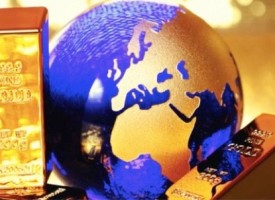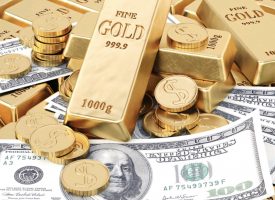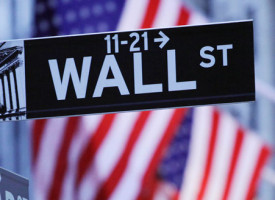On the heels of a rough couple of weeks in the gold and silver markets, today one of the top money managers in the world told King World News that investors should forget this pullback because the price of silver is headed way above $100.
Stephen Leeb: “Perhaps, despite my best efforts to convince you otherwise, you still don’t believe in gold. You are convinced the world is in good shape and that China and the U.S. will be buddies and mutually prosper. And you believe the dollar will remain the world’s reserve currency…
IMPORTANT…
To find out which company is set to become one of the
highest grade producing gold mines on the planet
CLICK HERE OR BELOW:
Gold Will Be The Center Of The New Monetary System
You certainly have a right to your opinion. Moreover, I hope you are right, and that I have missed something. Still, I vehemently disagree with you, for all the reasons I have been citing in these interviews. I believe our time has passed and the East, led by China, is headed for hegemony. China wants gold to be at the center of a new monetary system, and China will get its way.
But instead of arguing this case yet again, let me offer an alternative investment that will flourish whether I’m right or wrong about gold. Silver, the white metal, is ideally suited for both a gold-dominated world and a world of prosperity. In fact, you can argue it is suited for nearly all possible worlds that could lie ahead.
$100+ Silver & A World In Turmoil
A world without prosperity will likely be one with a lot of turmoil. That’s a world in which gold will likely be king, with silver following close behind. On the other hand, in a prosperous world the demand for silver as an industrial metal should soar, while supply will be harder and harder to come by. Most leading research houses agree that mined silver supply has peaked. The Thompson Reuters subsidiary GFMS argues mined supply will “trend lower in the foreseeable future” and adds that declining mining supply “is expected to be a key driver in annual deficits in the silver market going forward.”

China Understands Silver
For the past few years I have been forecasting triple-digit silver, and I continue to believe I will get the last laugh on those who see the white metal remaining range-bound for the foreseeable future. The only country that apparently sees how severe the coming silver squeeze will be is China. Given China’s ability to think long-term I’m happy to be in that company.
About 70 percent of silver production is the byproduct of the mining of other metals, particularly lead, zinc, copper, and gold. While the supply of silver aligns with the supply of other metals, demand for silver aligns with demand for other metals. Some 70 percent of mined silver is used in industry, reflecting silver’s very special properties. It’s the best conductor of electricity, better even than copper. It is also the best thermal conductor and among the most reflective metals. And, like gold, it is extremely malleable and very strong and enduring. This combination of properties has made silver an industrial star.
Currently silver’s major industrial use is in the electronic products that define our information age, including cell phones, computers, keyboards, and more. The ability to pack transistors ever more densely has led to smaller devices like smartphones replacing larger desktops. That has meant less silver needed per computing device, keeping electronics demand for the metal flat for about a decade. But that substitution has gone about as far as it can. Computing devices have reached limits in terms of how small they can become – both physical limits to how many transistors can be crammed into a space and human limits in terms of how small a screen the human eye can comfortably view things on. Going forward, the Internet of ‘things,’ which will keep the number of computing devices growing swiftly, will translate into growing electronic demand for silver.
About a decade ago the largest industrial demand for silver was photography. But today silver-based photography has been largely supplanted by digital photography, whose use of silver is limited to the amount needed in the electronic devices that take the pictures. Silver is still used in x-rays and in a wide variety of other applications ranging from water purification to wood preservation. Still over the past decade industrial demand for silver has shrunk.
But the reaching of limits in terms of computer size – in conjunction with one other major application – suggests we’re at a point of inflection when it comes to silver’s industrial use going forward.
 Silver Demand For Solar Will Continue To Explode
Silver Demand For Solar Will Continue To Explode
That other application is in photovoltaics (PV), which is the largest component of solar energy. Silver has a major and growing role to play in renewable energies. Indeed, the common wisdom is that PV will be the dominant renewable energy. At current costs, solar energy is on average as cheap as or cheaper than wind. One reason is that siting wind turbines offshore is a very expensive proposition. Moreover, despite explosive growth in recent years, solar energy accounts for less than 1 percent of the world’s total energy consumption. Extremely rapid growth is more than likely for the foreseeable future as world energy consumption continues to rise and fossil fuels become ever more expensive.
One caveat is that as with electronic devices we have reduced the amount of silver used in PV, but as with electronic devices we are close to the limit to how much we can reduce. The numbers cited below assume further small reductions.
CRU Consulting predicts that between 2016 and 2020, PV will grow at an average annual rate of 23 percent, translating into a tripling of silver demand for PV, or an additional 4,000 metric tons a year. That will come on top of growth in demand from electronics and other uses of silver. The bottom line is that by 2020, industrial uses for silver supplemented by demand for silver jewelry and silverware will exceed silver supplies, of which more than 85 percent is mined silver and the remainder scrap.
The First Leg Was Silver’s Advance To $50
What’s missing from this calculus? Demand for silver as an investment, which accounts for nearly 30 percent of silver supply. Today when you subtract investment demand from total demand you end up with excess silver, which is counted as inventory. Silver inventories have been increasing since 2009. Or to put it another way, the last time there was a draw on inventories was in the three-year period 2006-2008. Moreover, inventories were not replenished until 2011. During that six-year period in which inventories were below their peak, prices soared from about $8 an ounce to $50.
Note that my inventory numbers are ones that I derived from supply and demand figures from GFMS as well as other sources. GFMS lists its inventory numbers separately, and these numbers present a somewhat different picture. The biggest difference is that GFMS shows silver inventories jumping dramatically in 2009 to new highs and then continuing to rise. Clearly their inventory numbers don’t mesh with their supply and demand numbers.
The apparent reason – one that lacks logic – is that GFMS makes an independent estimate of silver held in custodian vaults, which in the 2009-11 represented about 50 percent of inventories, and is estimated, thanks to dramatic accumulation of silver by China, to be much more today. GFMS has admitted that it doesn’t have a good handle on silver in custodian vaults. My guess is that the firm simply overestimated the amount of silver in these vaults during the 2009-2011 period. Other sources have noted that GFMS dramatically underestimates China’s demand for gold. (I won’t comment on any possible motivation.)
The key point is that a fall in silver inventories is a very big deal. Even if the GFMS inventory numbers were right, it would still be true that a drawdown in inventories sparked a sixfold gain in silver. While a lot can happen between today and 2020, best estimates are that silver inventories will begin a protracted decline by the start of the next decade if not sooner. The last decline sparked a rally that in today’s terms would send silver past $100.
Silver May Be Headed Multiples Above $100
Do you have to wait until 2020 to see silver start gaining? Probably not. Between 2004 and 2006, silver climbed about threefold, perhaps anticipating the tighter inventory situation, perhaps because other commodities and gold were also rising during that period. But coming back to where I began this interview, I wanted to illustrate that even if you don’t believe in gold, a silver shortage lies in the fairly near future and will likely be a permanent shortage that should lead to a multifold gain in the white metal. That $100 number could easily turn out to be very modest.”…KWN has now released the remarkable audio interview with legendary James Dines and you can listen to it by CLICKING HERE OR ON THE IMAGE BELOW.
***ALSO JUST RELEASED: James Dines – The World Is Sleepwalking Toward A Cliff CLICK HERE.
© 2017 by King World News®. All Rights Reserved. This material may not be published, broadcast, rewritten, or redistributed. However, linking directly to the articles is permitted and encouraged.









